Event Calendar – Click on a day for more details
Quarterly Mailer – Was sent to members.
| Sun | Mon | Tue | Wed | Thu | Fri | Sat |
|---|---|---|---|---|---|---|
| Raise the River: Intro and Refresher to Paddling 5:30 pm Raise the River: Intro and Refresher to Paddling @ Willow Grove Lake Jul 18 @ 5:30 pm Join us for the first Paddle of Raise the River! This is an Intro and Refresher to Paddling with Cheryl Fox of Al & Sam’s on Willow Grove Lake. Afterward explore Still Run. Check back soon for the link to register! | ||||||
| Raise the River: Laurel Lake Sunset Paddle 6:30 pm Raise the River: Laurel Lake Sunset Paddle Jul 26 @ 6:30 pm Check back soon for the link to register! | Raise the River Down Jersey Pineland Paddle: Muskee 9:00 am Raise the River Down Jersey Pineland Paddle: Muskee @ Muskee Creek Jul 27 @ 9:00 am – 11:00 am The paddle on the Muskee will be at 9:00 a.m. and followed by a riverside potluck lunch around 11:00 a.m. Raise the River Down Jersey Pineland Paddle: Manumuskin River 1:00 pm Raise the River Down Jersey Pineland Paddle: Manumuskin River @ Manumuskin River Jul 27 @ 1:00 pm The second Down Jersey Pineland Paddle will take place on the Manumuskin River at 1:00 p.m. | |||||
Meetings
MEETING DATES for 2024
PLEASE MARK YOUR CALENDAR
Second Wednesdays of the odd-numbered months 6:30-8:30 p.m. at the Cumberland County Improvement Authority Meeting Room, 745 Lebanon Road, Millville, NJ 08332
Meetings are currently being conducted in-person until further notice.
January 10, 2024
March 13, 2024
May 8, 2024
July 10, 2024
September 11, 2024
November 13, 2024 – Annual Meeting
MEETING WEATHER ADVISORY– During the winter months our regularly scheduled meetings will be canceled if Millville Public Schools have issued a foul weather closure. If weather has gotten nasty late in the day please exercise good judgment. Should you have any further questions, feel free to call the office at 856-300-5331. Have a safe winter.
Natural History Calendar by Month
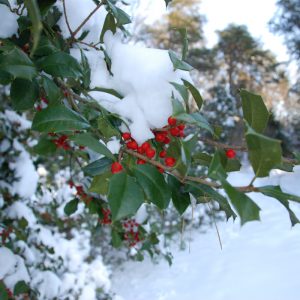 Newly fallen snow makes it easy to find and study animal tracks.
Newly fallen snow makes it easy to find and study animal tracks.- Waterfowl numbers are at the height of their activity on the Maurice River, November through mid-March.
- Snow geese stopover in region, December through March.
- Bald Eagle Surveys take place.
- First mating season for gray squirrels.
- Robins eat holly berries.
- Great horned owls, America’s earliest nesting owl, may be on eggs by the end of the month.
- As days lengthen, tufted titmice and cardinals start singing.
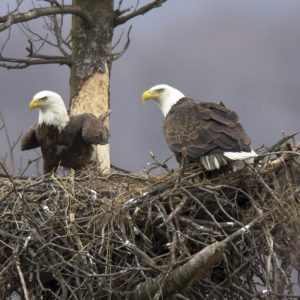 Great horned owls on nests incubating.
Great horned owls on nests incubating.- Waterfowl numbers are at the height of their activity on the Maurice River, November through mid-March. Peak numbers occur February through mid-March.
- Local eagle population begins nesting.
- Snow geese stopover in region, December through March.
- Clean out bluebird boxes and birdfeeders.
- Peek of breeding season for coyotes.
- White-tailed deer dropping antlers.
- Skunk cabbage flowers are emerging from the ground, in wetlands. As they grow they generate heat, which melts the frozen ground around them. Alder catkins beginning to swell, and open on the first warm days.
- Broom crowberry in bloom in the Pinelands.
- Mourning cloak butterflies emerge from hibernation on warm days.
- Killdeer and great blue herons return north as waterways thaw.
- Chipmunks reappear.
- Best time for viewing tundra swans.
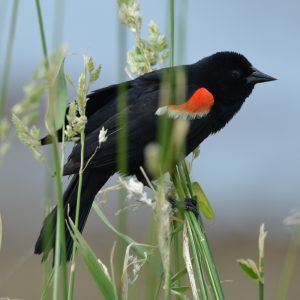 Red-winged blackbirds return to marshes.
Red-winged blackbirds return to marshes.- Wood frogs are the first frogs to begin calling, sounding like distant ducks quacking.
- Spring azure butterflies emerge from their overwintering chrysalis on warm days, living only 3 days they need to quickly find a mate, lay eggs, and create the next generation.
- Woodchucks emerge from hibernation.
- Northern hemisphere- vernal equinox
- Waterfowl numbers are at the height of their activity on the Maurice River, November through mid-March. Peak numbers occur February through mid-March.
- Osprey return from South American wintering grounds.
- Snow geese stopover in region, December through March.
- Male skunks wander, looking for mates.
- Red maples flower in late March, with male flowers and female flowers on separate trees.
- Roadside introduced weeds bloom.
- Eastern screech owls, New Jersey’s most common owl, lay eggs through May.
- Woodcocks begin courtship flights.
- Male goldfinches begin to molt into their yellow breeding plumage.
- Eastern phoebes return.
- Great Blue Herons return to their rookeries.
- Spring peepers begin to sing.
- Bluebirds begin laying eggs.
- Tent caterpillars spin webs in fruit trees.
- Prepare purple martin houses.
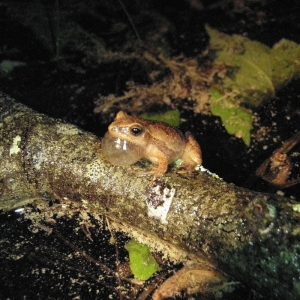 Pond turtles emerge from hibernation.
Pond turtles emerge from hibernation.- Whip-poor-wills begin to arrive.
- Spring beauty and trout lily bloom in deciduous woodlands.
- Spring peepers begin calling when vernal ponds warm to about 50 degrees F.
- Shad migrate up the Delaware River to spawn.
- Ruby-throated hummingbirds, purple martins, and warblers begin to arrive.
- Box turtles breed.
- Most juncos and white-throated sparrows have left by the end of the month.
- Rose-breasted grosbeaks show up at feeders for a few days on their way north.
- Peak of spring raptor migration.
- Swamp pink, federally threatened lily, begins to bloom.
- Southern twayblade orchid and trailing arbutus in bloom.
- Look for young foxes playing around den sites.
- Look for morels now.
- The first brood of monarch butterflies is emerging from their chrysalis.
- Red-winged blackbirds return to marshes.
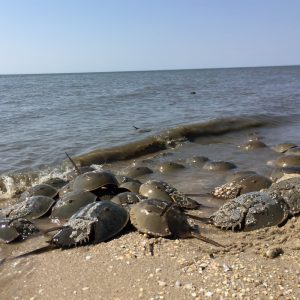 Jack in the pulpit, pink lady’s slipper, and mayapple bloom.
Jack in the pulpit, pink lady’s slipper, and mayapple bloom.- Arethusa orchid blooms.
- All breeding songbirds back and in full song.
- Horseshoe crabs begin to spawn.
- Migratory shorebirds stop over to feast on horseshoe crab eggs in order to fatten up for their journeys to northern nesting grounds. (red knots, sanderlings, semi palmated sandpiper, ruddy turnstone).
- NJ Audubon holds its World Series of Birding aptly timed with shorebird migration.
 During courtship, a cedar waxwing pair may repeatedly pass a flower petal or insect back and forth.
During courtship, a cedar waxwing pair may repeatedly pass a flower petal or insect back and forth.- White-tailed deer are giving birth.
- Longest day of the year – summer solstice.
- Pond turtles are digging nests and laying eggs, which will hatch in approximately 90 days.
- Mountain laurels and fringetree are in bloom.
- Herons can be found with young in rookeries.
- Wood duck and mallard ducklings hatch.
- Canada geese begin molting
- Rose pogonia and grass pink orchid bloom.
- Songbird nesting season.
- White tail bucks in velvet.
- Bald eagles fledging.
- Most osprey chicks are banded.
- Pine snakes lay eggs between mid-June and mid-July.
- Watch for diamondback terrapins, box turtles, and other turtles crossing roadways as they search for the perfect spot to lay their eggs.
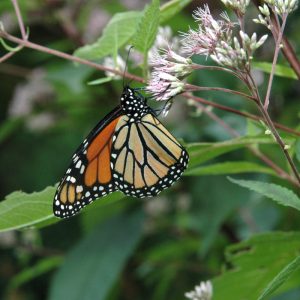 Blueberries and huckleberries ripen.
Blueberries and huckleberries ripen.- Morning sounds are whip-poor-will, owl, robin wood thrush, red-eyed vireo, and pewee. Evening sounds are Fowler’s toads, carpenter frogs, cicadas, katydids, and crickets.
- Most ospreys are fledging.
- Bog asphodel, now found only in New Jersey, blooms in early July in Pinelands savannahs.
- Butterflies: spicebush swallowtail, little wood satyr.
- Monarch butterfly numbers are increasing in our gardens and natural areas, when milkweeds have been planted or grow.
- Many turtles are laying eggs, and raccoons, skunks, and opossums are digging up and eating them.
- Pine snakes lay eggs between mid-June and mid-July.
- Many birds are busy with second broods, except late nesters like American goldfinch and eastern bluebird.
- Thistle plants are beginning to seed; goldfinches gather thistledown for nesting materials.
- Listen for the feeding calls of young barred and great horned owls.
- First southbound songbird migrants in late July, including many yellow warblers and bobolinks.
- Shorebirds that bred in the Arctic are returning through the area, heading south.
- White fringed, yellow fringed, yellow crested, and southern yellow orchids begin to bloom at the end of the month.
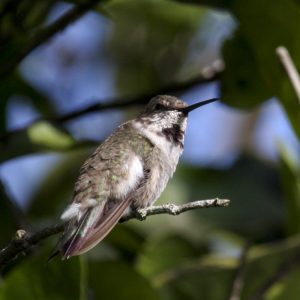 Perseid meteor shower.
Perseid meteor shower.- Second brood of hummingbirds begins to appear at feeders.
- Sweet goldenrod, early goldenrod, cardinal flower, asters and other late-summer flowers bloom.
- Sensitive vetch in bloom, a federally protected plant that grows along the Manumuskin.
- Great blue herons disperse from their rookeries.
- Purple martins begin roosting in phragmites along the Maurice River in preparation for their southern migration. Maurice River Township, CU, & NJAS, and host festival.
- Shorebirds pass through New Jersey again on their southward migration to Chile. Adults are still in breeding plumage.
- Fall raptor and neo-tropical songbird migration begins in mid-August.
- Adult osprey begin their trek for South America.
- Gray squirrels give birth to second brood.
- Hummingbirds are ravenous before migration.
- American goldfinches finish nesting late in this month.
- Birds are feeding on fruits of flowering dogwood trees.
- Catalpa sphinx caterpillars devour leaves of catalpa trees. Sphinx caterpillars are inturn eaten by birds such as cuckoos.
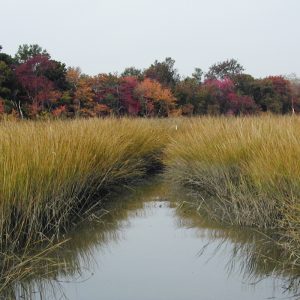 The final fall generation of monarch butterflies migrates south to the mountains of Mexico, September through October.
The final fall generation of monarch butterflies migrates south to the mountains of Mexico, September through October.- Northern hemisphere – autumnal equinox.
- Black gum foliage turns red – first tree to get its autumn color, followed quickly by sassafras and then red maple.
- Wild grapes ripen.
- First year osprey begin southern migration.
- A variety of turtles’ eggs hatch.
- Robins begin to form large flocks.
- Bats busy feeding, building fat reserves for hibernation and migration.
- Broad-winged hawk migration peaks in mid-month.
- Deer still in velvet.
- Ripe wild cherries attract many birds.
- Most ruby-throated hummingbirds have departed by the end of the month.
- Sora rails and red-winged blackbirds feast on wild rice on southern migration route.
- Warm water and cold air create early morning fog.
- Many resident birds start to migrate south: whip-poor-wills, nighthawks, kingbirds, flycatchers, and swallows.
- By late month most migrating warblers passing through are yellow-rumped warblers.
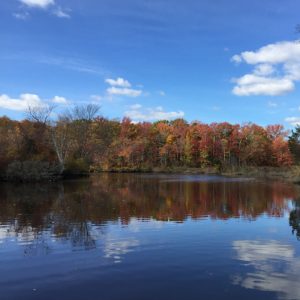 Pine barrens gentian in bloom in the Pinelands.
Pine barrens gentian in bloom in the Pinelands.- Goldenrods, asters, bonesets, and blazing star in bloom.
- Cranberry harvest in the Pinelands.
- Autumn foliage colors peak in late October.
- The largest number of hawks migrate though Down Jersey, primarily falcons and accipiters, occur early in October; the greatest variety occurs later in the month when buteos are are added to the ranks.
- Fox sparrows, one of the largest sparrows, are often seen under seed feeders during their autumn migration.
- Juncos return.
- Buck moths, a daytime flying moth, are abundant in the Pines.
- Woolly bear caterpillars (Isabella tiger moth) are often seen traveling along the ground.
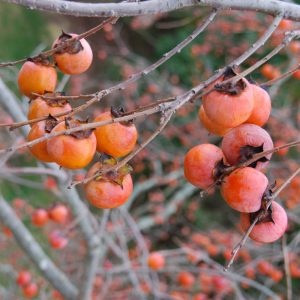 Persimmons ripen and are considered sweet after first frost.
Persimmons ripen and are considered sweet after first frost.- Witch hazel in bloom.
- Groundhogs (aka woodchucks) and chipmunks go into hibernation.
- Bats seek their hibernating sites.
- Pine snakes retreat to their winter hibernacula.
- White-throated sparrow is a regular winter bird feeder visitor.
- White-tail deer rutting begins.
- Waterfowl numbers are at the height of their activity on the Maurice River, November through mid-March.
- Tundra swans begin to appear in shallow ponds, lakes, and impoundments (not to be confused with the invasive & detrimental mute swan).
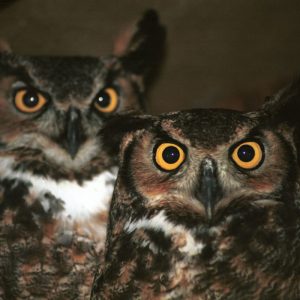 Geminid meteor shower.
Geminid meteor shower.- Shortest day of the year – winter solstice.
- Freezing weather north of our region brings wintering bald eagles to southern New Jersey.
- Waterfowl numbers are at the height of their activity on the Maurice River, November through mid-March.
- Raptor migration ends mid-month.
- Snow geese stopover in region, December through March.
- Great horned owls are pairing up.
- Short-eared owls have arrived for the winter and can be found hunting low over salt marshes at dusk and on overcast days.
- Take part in annual Christmas bird count, end of December/beginning of January.
Adapted from CU’s Seasons on the Maurice, Gloucester County Nature Club, A Pine Barren Odyssey by Howard Boyd, Bits of a Batsto Year by Annie M. Carter, Birding Cumberland by Clay Sutton, and Clay and Pat Sutton’s personal nature notes.
